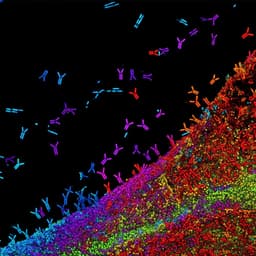
Environmental Studies and Forestry
Monitoring of over-the-counter (OTC) and COVID-19 treatment drugs complement wastewater surveillance of SARS-CoV-2
C. Lee, M. Wang, et al.
This groundbreaking study by Cheng-Shiuan Lee and colleagues explores wastewater surveillance for SARS-CoV-2, focusing on the presence of COVID-19 treatment drugs and their metabolites. The research reveals intriguing correlations between pharmaceuticals and viral loads, paving the way for more accurate predictions of COVID-19 cases using cutting-edge Bayesian modeling.
~3 min • Beginner • English
Introduction
The study addresses how chemical biomarkers in wastewater can complement RNA-based wastewater-based epidemiology (WBE) for COVID-19 surveillance. While SARS-CoV-2 RNA in sewage effectively tracks community infection dynamics and can provide early warning, RNA surveillance has limitations including stability in sewage, methodological uncertainties, and population/flow variability. Given that infected individuals may self-medicate with OTC drugs (e.g., acetaminophen) and, when severely ill, receive treatment drugs (e.g., hydroxychloroquine, remdesivir) that are excreted and reach wastewater, the authors hypothesize that monitoring these pharmaceuticals and their metabolites can reflect community symptom management and treatment patterns, and improve prediction of confirmed COVID-19 cases. The purpose is to identify complementary chemical biomarkers correlated with SARS-CoV-2 RNA and reported cases and to develop Bayesian models that integrate viral RNA and drug markers to predict community case counts over time.
Literature Review
WBE has been widely used to monitor chemicals, biomarkers, and pathogens at population scale, offering near-real-time insights but facing challenges such as biomarker stability, variable flows, and population estimation. Numerous studies have correlated SARS-CoV-2 RNA in wastewater with reported cases across countries, reporting lead times typically from 0 to 14 days, demonstrating early-warning potential. Forecasting models using WBE data exist, including SEIR-based and machine-learning approaches, but many prior studies are qualitative (correlations/lead times without quantitative transformation to case counts), have short forecasting horizons, or show large prediction errors and uncertainty. Olesen et al. summarized applications and limitations, underscoring the need for improved quantitative modeling. There is growing interest in augmenting RNA surveillance with other biomarkers such as pharmaceuticals, including COVID-19 treatment drugs (e.g., chloroquine/hydroxychloroquine, remdesivir) and OTC drugs, which may better capture community behaviors like symptom treatment and hospitalization. Prior work has also explored antiviral usage in wastewater and alternative population normalization biomarkers.
Methodology
Study site and sampling: Untreated raw sewage influent was collected from the largest WWTP in Suffolk County, NY, serving ~330,000 people (~30.5 MGD). An autosampler composited 24-h samples (every 15 min) kept <6 °C. Subsamples (500 mL) were transported on ice (~1 h) and processed the same day for viral analysis; remaining aliquots were split and stored at -80 °C for drug analysis and archiving. Suspended particles for drug analysis were removed by 1 µm glass fiber filtration prior to freezing. Sampling schedule: daily (June 3–9, 2020), weekly (June 9–July 7, 2020), biweekly (July 7–Dec 22, 2020), twice weekly (Jan 2021–Jan 6, 2022). Total wastewater samples n = 183.
Viral RNA detection: 24-h composites were centrifuged (4200 rpm, 30 min, 4 °C) to remove large debris; supernatant was spiked with bovine coronavirus (BCoV) to assess recovery; viral particles in 40 mL were precipitated using PEG 8000 and NaCl, incubated overnight at 4 °C. RNA was extracted (Qiagen QIAamp DSP viral RNA mini kit), eluted in 100 µL, quantified (NanoDrop), and immediately reverse-transcribed (High Capacity RNA-to-cDNA; 37 °C, 60 min). Digital PCR used N1 primers/probe (CDC-recommended) on QuantStudio 3D Digital PCR, with RNase P as internal control; NTC and positive control plasmids included. Cycling: 95 °C 10 min; 40 cycles of 95 °C 5 s, 55 °C 40 s; 98 °C 10 min. LOD for N1: 1.4 copies/reaction.
Pharmaceuticals analysis: Targeted COVID-19 treatment drugs (remdesivir, chloroquine, hydroxychloroquine) and metabolites, plus 26 pharmaceuticals (including OTCs) selected based on high US prescription rates and environmental detection frequencies. Standards and isotopically labeled surrogates obtained from commercial suppliers. COVID-19 treatment drugs: solid-phase extraction (Waters Oasis HLB 200 mg, 6 cc) of 100 mL wastewater spiked with hydroxychloroquine-D4 surrogate, yielding ~25x preconcentration; extracts stored at -20 °C, diluted 50:50 MeOH:H2O and spiked with internal standards prior to analysis. Other pharmaceuticals: direct injection after 10x dilution to 10% MeOH; internal standards added.
Instrumental analysis: Agilent 6495B triple-quadrupole LC–MS/MS in ESI+ with MRM for precursor/product ions (details in Tables S1–S2). QA/QC included surrogates/internal standards.
Stability experiments: To assess 24-h stability under sewer-relevant conditions, 50 ng of selected COVID-19 treatment and OTC drugs were spiked into 50 mL unfiltered raw wastewater and stored at 4, 12, and 20 °C (triplicates). Aliquots at t=0 and t=24 h were analyzed using the above methods.
Epidemiological data: Daily confirmed COVID-19 cases at ZIP-code level from Suffolk County Department of Health were aggregated across 13 ZIP codes in the WWTP catchment to a 7-day rolling average. Stony Brook University Hospital provided daily hospitalized cases and amounts of prescribed hydroxychloroquine and remdesivir (from Oct 3, 2020 onward) to contextualize treatment trends (not used as quantitative proxies for sewershed loads).
Population normalization: Caffeine was used as a population biomarker due to stability (<10% degradation in 24 h). Over ~20 months, caffeine averaged 88.2 ± 20 µg/L (48.2–148 µg/L). Viral and chemical time series were normalized by caffeine via [Virus or drug]_t / ([Caffeine]_t / [Caffeine]_avg).
Bayesian modeling: Generalized linear models with binomial likelihood for confirmed cases C_t ~ Binomial(N, p_t), N=3.3×10^5 (sewershed population). logit(p_t) = α + Σ β_i X_i including lags (t−1, t−2, t−3) of predictors (log10-transformed virus copies; other chemicals rescaled 0–1 by dividing by sample maxima). Priors α ~ Normal(α0, σα); β_i ~ Normal(βi0, σβi). Variable selection guided by data exploration and cross-correlation. Models evaluated using MCMC with diagnostics (PSRF, ESS, trace plots) and WAIC for model selection. Three predictor sets were considered: (a) virus only, (b) virus + desethylhydroxychloroquine, (c) virus + acetaminophen + desethylhydroxychloroquine. Model validation used an external dataset (Jan–May 2022; 39 measurements) for virus-only predictions due to lack of concurrent drug data.
Key Findings
- Viral RNA in wastewater strongly tracked confirmed cases over ~20 months, with Pearson correlation R = 0.81 (p < 0.01) and an estimated lead time of 3–4 days.
- COVID-19 treatment drugs and metabolites were detected with varying frequencies (9–100%), reflecting instability in wastewater; 13 of 26 monitored pharmaceuticals showed 100% detection (n = 111 samples).
- Significant correlation between SARS-CoV-2 genes and desethylhydroxychloroquine (DHCQ, HCQ metabolite): R = 0.30 (p < 0.01). Peaks in DHCQ (Nov 2020, Dec 2021) aligned with viral gene increases.
- Remdesivir exhibited two peaks: immediately after FDA EUA and again during rising cases in Sept 2021; overall temporal similarity to cases/viral loads was limited, likely due to instability.
- Acetaminophen was abundant (mean 83.6 µg/L; range 19.5–237 µg/L) and significantly correlated with confirmed cases overall (R = 0.66, p < 0.01) and with viral loads, particularly during the Omicron-dominant period. Lead time vs confirmed cases was 0–2 days.
- Caffeine (mean 88.2 µg/L; 48.2–148 µg/L) and paraxanthine (mean 23.1 µg/L; 12.6–37.8 µg/L) were among the most abundant chemicals.
- Cotinine (nicotine metabolite) was negatively correlated with confirmed cases (R = −0.42, p < 0.01).
- Bayesian models incorporating viral RNA alone and with drug markers reproduced temporal trends in confirmed cases from June 2020 to Jan 2022. Models including acetaminophen and DHCQ better tracked the Omicron surge.
- External validation (Jan–May 2022; virus-only inputs) showed good agreement in trends but underpredicted the peak magnitude, consistent with measurement uncertainties or human factors.
- Overall, integrating OTC pharmaceutical monitoring, especially acetaminophen, can complement RNA surveillance and improve case trend prediction.
Discussion
The findings support the hypothesis that chemical biomarkers in wastewater can complement SARS-CoV-2 RNA monitoring to better assess community-level COVID-19 dynamics. While antiviral treatment drugs showed detection patterns consistent with usage (e.g., remdesivir post-EUA; HCQ metabolites aligning with viral surges), their limited stability in wastewater reduced their utility as robust quantitative markers. In contrast, acetaminophen, a widely used OTC analgesic/antipyretic, strongly correlated with confirmed cases and viral loads, especially during the Omicron wave, and exhibited a short 0–2 day lead time consistent with symptom onset and immediate self-medication. This underscores the relevance of OTC drug monitoring as a proxy for symptomatic burden in the community. The Bayesian GLM framework transformed wastewater measurements (virus and pharmaceuticals) into probabilistic case estimates, capturing long-term temporal patterns and improving fit during specific surges when acetaminophen was included. These results demonstrate that combining viral RNA with select pharmaceutical markers enhances interpretability and predictive performance of WBE for public health surveillance, potentially offering actionable early insights during variant-driven waves and future respiratory outbreaks with similar symptomatology.
Conclusion
Viral RNA in wastewater reliably reflected COVID-19 case trends across variant periods with a 3–4 day lead time. COVID-19 treatment drugs and metabolites were detected but exhibited low stability, limiting their use as primary biomarkers. Acetaminophen, abundant and analytically straightforward, correlated with both viral loads and confirmed cases and presented a short 0–2 day lead time, aligning with typical symptom progression and self-medication. Desethylhydroxychloroquine also correlated with viral concentrations. Integrating viral RNA with pharmaceutical data in a Bayesian modeling framework reproduced case trends over ~20 months and enabled accurate out-of-sample prediction using viral loads alone. Monitoring OTC drugs like acetaminophen can complement RNA-based WBE and may indicate broader shifts in population health. Future work should expand biomarker panels, improve stability assessments, incorporate solid-phase viral monitoring where appropriate, and continue model updating for robust, real-time public health forecasting.
Limitations
- Limited availability of analytical standards during early pandemic response (e.g., isotopically labeled remdesivir), constraining method development and quantitation accuracy.
- Viral extraction optimized for filtered wastewater (aqueous phase), potentially underestimating virus associated with solids; however, temporal trends are unlikely affected. Sludge/solids may be preferable for particulate-associated virus monitoring.
- Instability of certain treatment drugs in wastewater reduces their utility as quantitative markers and contributes to variable detection frequencies.
- Lead times and correlations may vary by site due to differences in sewer system design, sampling protocols, climate, and testing/reporting practices for confirmed cases.
- External validation was limited to virus-only inputs due to lack of concurrent drug data for Jan–May 2022; peak underprediction suggests remaining uncertainties in measurement and human behavior factors.
Related Publications
Explore these studies to deepen your understanding of the subject.







